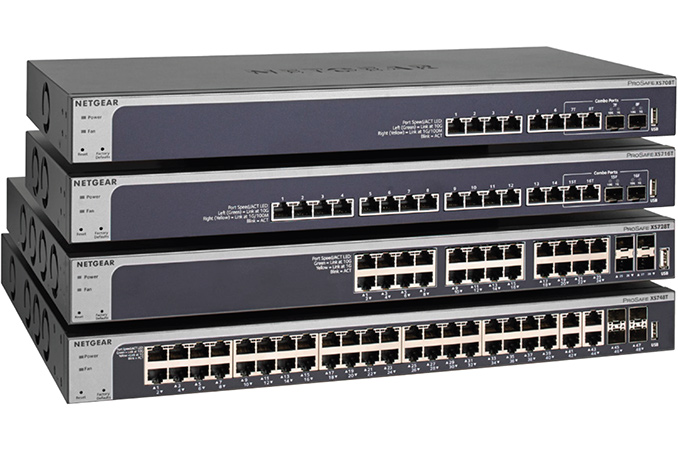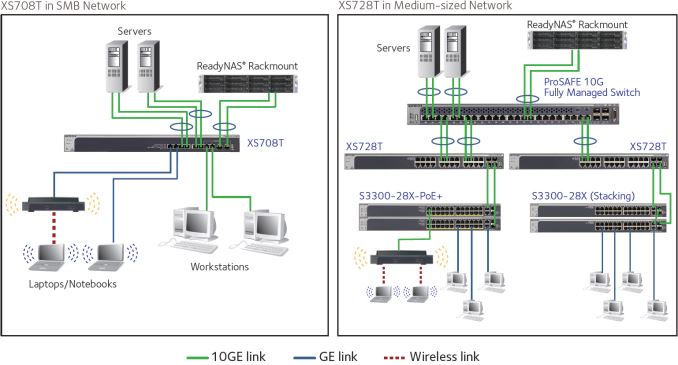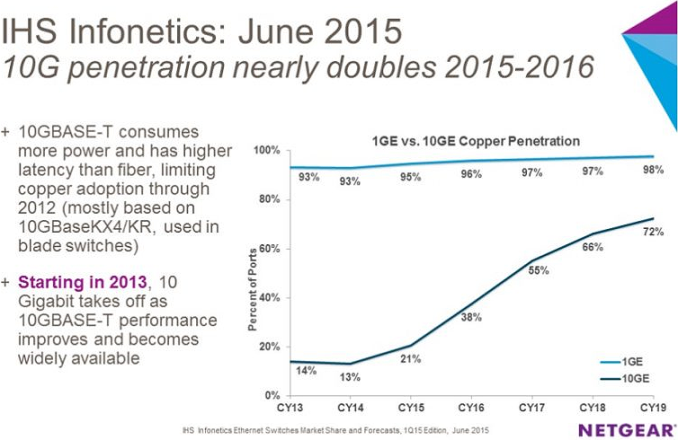Netgear Introduces Second-Gen ProSAFE 10GBase-T Switches for SMBs
by Anton Shilov on May 17, 2016 8:30 AM EST- Posted in
- Networking
- NetGear
- 10GBase-T

NetGear has introduced four new ProSAFE 10 GbE switches for small and medium businesses, upgrading their first generation of XS708E and XS712T parts. The new switches support both copper (10GBase-T) and fiber links, IPv6 management as well as Layer 2+/Layer 3 Lite features. NetGear claims that the new switches are significantly more cost-efficient than previous-generation 10 GbE products.
Internet speeds and file sizes increased orders of magnitude in the last ten years and for many offices (and prosumers), Gigabit Ethernet or basic teaming might no longer be enough. As a result, many businesses and individuals these days are evaluating migration to 10 Gigabit Ethernet, which of course has immediate high performance, but is more expensive on per-port basis than traditional GbE (as well as power consumption when looking for RJ45 compatibility). Fortunately, in the recent quarters, a number of companies have started to offer moderately priced 10 GbE switches supporting both copper and fiber links that can enable a more cost-efficient transition to 10 Gigabit networks.
The four new ProSAFE 10 GbE Smart Managed Switches from NetGear are the 8-port XS708T, the 16-port XS716T, the 24-port XS728T and the 44-port XS748T. The 8- and 16-port switches are based on single-core ARM Cortex-A9 600 MHz processor, whereas the more powerful 24- and 44-port models feature dual-core ARM Cortex-A9 800 MHz processor.
| NetGear ProSAFE 10 GbE Smart Managed Switches | ||||||
| XS708T | XS716T | XS728T | XS748T | |||
| 10GBase-T RJ-45 | 8 | 16 | 24 | 44 | ||
| SFP Ports | 2 shared | 4 dedicated | ||||
| CPU | Single-core ARM Cortex-A9 600 MHz | Dual-core ARM Cortex-A9 800 MHz | ||||
| RAM | 512 MB | |||||
| Non-Volatile Memory | 8MB SPI + 256 NAND | |||||
| Packet Buffer | 2 MB | 3 MB | ||||
| ACLs | 100 shared | 164 shared | ||||
| MAC Address Table RP/NDP Table VLANs |
16K MAC 738 ARP/NDP 256 VLANs |
16K MAC 1K ARP/NDP 512 VLANs |
||||
| Fabric Bandwidth | 160 Gbps | 320 Gbps | 560 Gbps | 960 Gbps | ||
| Rated Latency | 10GBASE-T: <3.012 μs SFP+: <2.466 μs |
10GBASE-T: <2.624 μs SFP+: <2.128 μs |
10GBASE-T: <11.649 μs SFP+: <2.619 μs |
10GBASE-T: <3.674 μs SFP+: <3.693 μs |
||
| Static Routes (IPv4 & IPv6) |
IPv4: 32 IPv6: 32 |
IPv4: 64 IPv6: 64 |
||||
| Multicast IGMP Group |
512 | |||||
| USB Port | One port for firmware and config access | |||||
| Rated Power Consumption | 49.5 W | 96.0 W | 134.9 W | 262.8 W | ||
| Price | $1558 | $2623 | unknown | $8198 | ||
The switches support modern VLAN features, such as protocol-based VLAN, MAC-based VLAN and 802.1x Guest VLAN; advanced QoS with L2/L3/L4 awareness and eight priority queues including Q-in-Q; dynamic VLAN assignment; IPv4 and IPv6 routing; IPv6 for management, QoS and ACL and so on. The devices come in rackmount form-factors and consume from 49.5 W to 262.8 W of power.
According to a survey of over 550 IT decision-makers in the U.S, U.K., and Germany ordered by NetGear and conducted by Palmer Research, approximately 33% of sub-500-employee businesses today already have 10 GbE switching to connect to modern 10 GbE servers and NAS. Meanwhile, a lot of those who currently do not use 10 GbE are considering to deploy it and plan to do so in the coming quarters. The survey says that by the end of 2017, 75% of the aforementioned organizations will have deployed a 10 GbE backbone by the end of 2017. Analysts from IHS (according to data provided by NetGear) seem to agree with the results of the survey and believe that adoption of 10 GbE is increasing rapidly these days.
Pricing of these switches are a lot higher than standard gigabit ethernet switches as 10GbE networks typically require the advanced management protocols for businesses and enterprise, whereas home users might be happy with a simple pass-through device. Because of the market, and the management requirements, we are still looking at above $150 per port for 10GbE. The NetGear ProSAFE XS708T and XS716T are available now for $1558 ($194.75 per port) and $2623 ($164 per port), respectively. The top-of-the-range XS748T will ship in July for $8198 ($186 per port). Pricing and availability of the XS728T were not touched upon by NetGear. By comparison, the popular first generation 8-port XS708E switch is retailing for $850 ($106.25 per port) at this point in its life cycle.
Sources: NetGear, ServeTheHome.












46 Comments
View All Comments
melgross - Tuesday, May 17, 2016 - link
When pricing is at the point where manufacturers think they can sell laptops, or desktops, with this technology, and, for laptops, when the power requirements drop enough, we will begin to see it.I remember back when Apple was the first to adopt 100Mbe for their entire lineup, and then later 1Gbe. That helped to kickstart Intel into supporting it on everything as well, back when they were still making about half of OEM motherboards.
WorBlux - Thursday, March 9, 2017 - link
WiGig comes in the newer premium Intel wireless chip-sets, and can hit about 7G over short-range. You may see a dock that support 10G given that, or a dedicated bridge.3DoubleD - Tuesday, May 17, 2016 - link
I'm just curious, what is it that makes 10GbE so expensive and power hungry? Is something radically different being done versus 1 GbE? At a cost of >$100 per port, doesn't fiber optics start to make more sense? I can certainly see one barrier to entry with fiber being the requirement that you re-cable your business/home.cm2187 - Tuesday, May 17, 2016 - link
My guess is that you are operating at speed close to the bandwidth of modern RAM, and that's per port.bcronce - Tuesday, May 17, 2016 - link
1Gb had the same issue until modern fabrication processes could be used. I remember 1Gb NICs with massive heatsinks and fans. Now they're integrated into a chipset and only consume 1mmx1mm, and passively cooled.22nm chipsets is when 10Gb will become a reality.
BurntMyBacon - Tuesday, May 17, 2016 - link
@3DoubleD: "I'm just curious, what is it that makes 10GbE so expensive and power hungry?"The power consumption of transistors can be divided into two groups: Switching power, and leakage power. Leakage power is power loss when the transistor is holding a state. It is generally a much smaller quantity than switching power, but has become a much larger quantity as transistor sizes have shrunk. FinFETs can do a lot to combat this rising leakage. Switching power is the power spend to "switch" the transistor from one state to the other. This is generally the dominant power usage. Assuming the exact same operations, switching the transistors 10 times as often should result in larger part of an order of magnitude more power draw. Of course, that's all before you even get off of the silicon. Practicalities in copper quality, construction tolerances, electromagnetic interferences, etc. force the NICs to use more complex algorithms to reach these speeds, causing even more transistor switches.
The good news is that, like processors, NICs benefit from process size reduction. This lowers the switching threshold of the transistors requiring less supply voltage to operate. Lower supply voltages reduce power for both switching and leakage.
Daniel Egger - Tuesday, May 17, 2016 - link
> I'm just curious, what is it that makes 10GbE so expensive and power hungry? Is something radically different being done versus 1 GbE?Yes, the amount of signal processing required to fish a stable link out of the "noise" coming out of the cable is just insane. After all existing cable (qualified for 500MHz operating frequency) was supposed to be able to carry the signal so they had to crank up the signal encoding quite a bit to make that possible.
> At a cost of >$100 per port, doesn't fiber optics start to make more sense?
Yes, it does but who cares?
> I can certainly see one barrier to entry with fiber being the requirement that you re-cable your business/home.
For 10GBase-T you'll at least need properly(!) installed Cat.6 (short distance only) or Cat.6a cabling anyway and who does already happen to have that anyway?
azazel1024 - Tuesday, May 17, 2016 - link
No, actually Cat5e supports 10GbE.Spec is 45 meters for 5e, 55 meters for 6 and 100 meters for 6a.
The issue of course is that in a high cross talk or outside EMI environment, that 5e and 6 will fall apart at much shorter distances than 6a will. So if you have a bundle of cables, 5e might only realistically support 10GbE at 10-15 meters, but under ideal conditions can carry it to 45 meters.
So your average power user at home can probably use old 5e or 6 cables in their walls with no problems, but in a data center, it would fall apart.
2.5 and 5GbE are supposed to support Cat5e to 100 meters, which is one of the reasons it is being pushed towards a ratified standard, along with the lower port cost and lower power dissipation. There isn't any real need in consumer market for 10GbE ANY year soon, other than we need something faster than 1GbE in the next couple of years and in the SMB market, most don't really need 10GbE. However, having 2.5GbE or even 5GbE and suddenly you have a product to address next generation wireless networking backhauls for consumers as well as SMB's that need >1GbE, but don't need 10GbE. All in a smaller, less expensive package.
Daniel Egger - Tuesday, May 17, 2016 - link
> No, actually Cat5e supports 10GbE.> Spec is 45 meters for 5e, 55 meters for 6 and 100 meters for 6a.
I unfortunately don't have access to IEEE documents but all other sources of information disagree strongly with what you're claiming, let's take e.g. Wikipedia for example (https://en.wikipedia.org/wiki/10_Gigabit_Ethernet)...
"10GBASE-T, or IEEE 802.3an-2006, is a standard released in 2006 to provide 10 Gbit/s connections over unshielded or shielded twisted pair cables, over distances up to 100 metres (330 ft).[35] Category 6a is required to reach the full distance of 100 metres (330 ft) and category 6 may reach a distance of 55 metres (180 ft) depending on the quality of installation, determined only after re-testing to 500 MHz. "
rahvin - Tuesday, May 17, 2016 - link
You just validated two of his 3 numbers. Cat 5e isn't listed as compatible but in a low noise environment it's capable of 10G at shorter distances. The number I remember is 30m not 45m. The difference between Cat 5e and Cat 6 is just the number of twists per inch. I doubt anyones tested it but even Cat 5 might work at 10Gbe over a foot or two. The better the cable the further it goes. If you go up to shielded Cat7 you can get (IIRC) 200m at 10G.Technically if a cable can't do 100M it doesn't meet the specification so even Cat6 isn't "approved" for 10G because it can only do 55m.